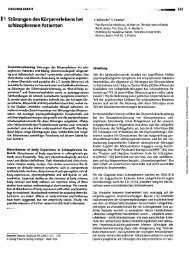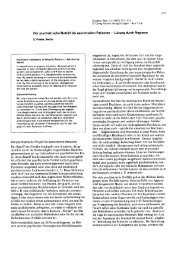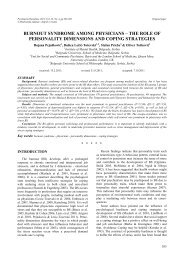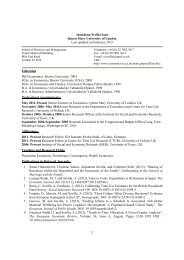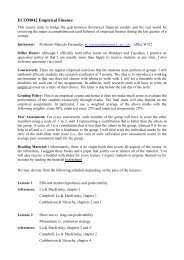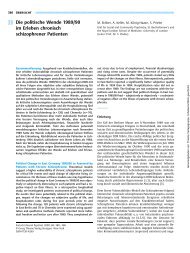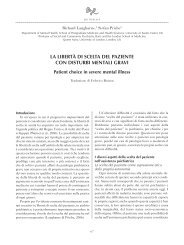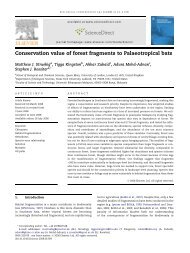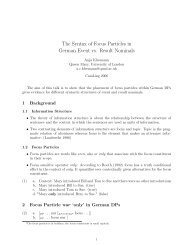Proofs - Personal Webspace for QMUL - Queen Mary, University of ...
Proofs - Personal Webspace for QMUL - Queen Mary, University of ...
Proofs - Personal Webspace for QMUL - Queen Mary, University of ...
You also want an ePaper? Increase the reach of your titles
YUMPU automatically turns print PDFs into web optimized ePapers that Google loves.
S28 F. Mammadova et al. / European Psychiatry 27 (2012) / supplement n°2 / S27-S31<br />
2. Materials and Methods<br />
2.1. Translation and pilot studies<br />
The original ZSDS was translated from English into Azerbaijani<br />
and Russian. The translations were then back- translated into<br />
English. The latter were conducted by an independent translator,<br />
who was not familiar with the English original. The back-<br />
translations were compared with the English ZSDS original by a<br />
native English speaker, and were ratifi ed as accurate and valid.<br />
Two pilot studies were conducted to facilitate adaptation<br />
<strong>of</strong> the validated ZSDS translations. The participants were asked<br />
to provide comments as necessary. The first pilot study <strong>of</strong><br />
Azerbaijani and Russian ZSDS versions was conducted among a<br />
sample <strong>of</strong> 30 subjects (21 Azerbaijani- speaking and 9 Russian-<br />
speaking). The fi rst pilot showed high drop- out rate, due to skipping<br />
<strong>of</strong> two items within the scale. These items were reworded<br />
in Azerbaijani and Russian to improve their acceptability. The<br />
reworded items were back translated into English to check<br />
similarity in terms <strong>of</strong> the meaning between the reworded items<br />
and the items in the English original. After the rewording the<br />
second pilot study was conducted among a sample <strong>of</strong> 45 subjects<br />
(42 Azerbaijani- speaking and 3 Russian- speaking) to check again<br />
the acceptability <strong>of</strong> the scale.<br />
The reworded Azerbaijani and Russian ZSDS versions were<br />
chosen <strong>for</strong> further use in the study.<br />
2.2. Reliability study<br />
The second phase <strong>of</strong> the study was a reliability study <strong>of</strong> the<br />
ZSDS Azerbaijani and Russian versions and was conducted on<br />
a sample <strong>of</strong> 175 subjects with a mean age <strong>of</strong> 32.66 SD=11.28<br />
(range 19- 64), 58 males (33.14%) and 117 females (66.86%). 104<br />
(59.43%) subjects <strong>of</strong> the sample were Azerbaijani- speaking and<br />
71 (40.57%) were Russian- speaking. The total sample consisted<br />
<strong>of</strong> 2 sub- samples: depressed patients diagnosed with depression<br />
according to ICD- 10 criteria [20] (n=55) and healthy control<br />
sample (n=120). The depressed patients’ sample (15 males and<br />
40 females) had a mean age <strong>of</strong> 32.74, SD=9.23 (range 18- 61). The<br />
healthy controls sample (43 males and 77 females) had a mean<br />
age <strong>of</strong> 32.61, SD=9.23 (range 19- 64).<br />
The depressed patients were attending Baku the city Psycho-<br />
Neurological Dispensary, outpatient department <strong>of</strong> the Republic<br />
Psychiatric Hospital, “Saglam Aile” Private Medical Center and<br />
“Funda” Private Medical Center, Baku, Azerbaijan. The healthy<br />
control sample was composed <strong>of</strong> members <strong>of</strong> the mentioned<br />
medical centers staff, relatives <strong>of</strong> the patients and the research team<br />
members. All sample subjects were tested once by the Azerbaijani<br />
or Russian ZSDS versions, according the fi rst language they spoke.<br />
All the obtained data were summarized in a database built<br />
on SPSS 16.0 s<strong>of</strong>tware <strong>for</strong> Windows, which was used <strong>for</strong> the<br />
later statistical analysis. Chronbach’s alpha coeffi cient <strong>for</strong><br />
the total scale was calculated to check the reliability <strong>of</strong> the<br />
ZSDS scale adaptations. Item- test correlations and alpha if<br />
item deleted were calculated to check per<strong>for</strong>mance <strong>of</strong> the<br />
individual items. Sensitivity and specifi city <strong>of</strong> the ZSDS scale<br />
at various cut- <strong>of</strong>f levels <strong>for</strong> the total sample were calculated<br />
to choose an optimal cut- <strong>of</strong>f point.<br />
3. Results<br />
The fi rst pilot study revealed a very high drop- out rate <strong>of</strong><br />
25 subjects (83.3%) due to skipping <strong>of</strong> the item 5 (missed out<br />
by 8 subjects (26.7%) and item 6 (missed out by 23 subjects<br />
(76.7%). The participants, who missed items <strong>of</strong> the ZSDS scale,<br />
were interviewed to provide reasoning <strong>for</strong> not completing the<br />
scale. According to comments and explanations, made by the<br />
participants, item 5 (I eat as much as I used to) was missed<br />
out due to the diffi culty in comprehension <strong>of</strong> the item’s word<strong>for</strong>-<br />
word translation. Skipping <strong>of</strong> item 6 (I still enjoy sex) was<br />
explained by the fact that it is culturally unacceptable to report<br />
about one’s sexual activity (or to be sexually active), particularly<br />
<strong>for</strong> local unmarried women (19 out 21 unmarried female participants<br />
(90.0%) missed item 6). There was a high overlap between<br />
subjects not responding both to items 5 and 6, respectively: 6 out<br />
8 subjects (75%), who missed item 5, missed item 6 as well. Such<br />
a high overlap can be explained by a high non- responsiveness<br />
to item 6, which covers 76.7% <strong>of</strong> the total sample in the fi rst<br />
pilot study.<br />
Item 5 was reworded and translated (in back translation) as<br />
“my appetite is as it used to be”. Item 6 was reworded as well,<br />
and translated back into English as “my sexual drive (interest)<br />
is as it used to be”.<br />
In comparison with the fi rst pilot, the second pilot study<br />
<strong>of</strong> the Azerbaijani and Russian ZSDS versions, which was<br />
conducted after the rewording <strong>of</strong> the scale items, revealed a<br />
signifi cantly lower drop- out rate <strong>of</strong> 20.0% (9 subjects) due to<br />
miss <strong>of</strong> item 6. Only 5 out 29 unmarried female participants<br />
(17.2%) missed item 6. There was no miss <strong>of</strong> item 5, as there<br />
had been in the fi rst pilot.<br />
The processing <strong>of</strong> the data from the second phase <strong>of</strong> the study<br />
(reliability study) revealed the following fi ndings: Chronbach’s<br />
alpha <strong>for</strong> the total scale was equal to 0.8727, and this value<br />
suggests that the scale has a good general internal consistency.<br />
However, items <strong>of</strong> the scale did not per<strong>for</strong>m similarly, in terms<br />
<strong>of</strong> the item- test correlations. The range <strong>of</strong> item- test correlations<br />
is signifi cantly wide with the highest correlation <strong>for</strong> item 1 (0.71)<br />
and the lowest <strong>for</strong> item 8 (0.24). Sixteen items, if deleted, would<br />
decrease the total scale alpha. three items (item 5, item 7, and<br />
item 8), if deleted, would increase the total scale alpha, and these<br />
three times have low item- test correlations, which are 0.38, 0.29,<br />
and 0.24 respectively. Item 6, if deleted, would have no impact<br />
on the total scale alpha (Table 1).<br />
Sensitivity and specifi city <strong>of</strong> the scale at various cut- <strong>of</strong>f levels<br />
<strong>for</strong> the total sample were calculated. (Table 2) The results established<br />
that an optimal cut- <strong>of</strong>f point can be suggested at >=45<br />
with sensitivity=90.91%, specifi city=80.83%. The area under ROC<br />
curve <strong>for</strong> ZSDS scores=0.9440. (Fig. 1)<br />
<strong>Pro<strong>of</strong>s</strong><br />
4. Discussion<br />
Publications on using <strong>of</strong> the ZSDS in various cultural contexts<br />
indicate that, despite being successful, there are diffi culties presenting<br />
the language adaptation <strong>of</strong> the scale. Adaptation <strong>of</strong> the<br />
ZSDS <strong>for</strong> using in a Spanish- speaking population demonstrated the<br />
scale’s usefulness [4], but presented interpretation diffi culties <strong>of</strong><br />
the scale’s Spanish version. The spanish version was needed to be




